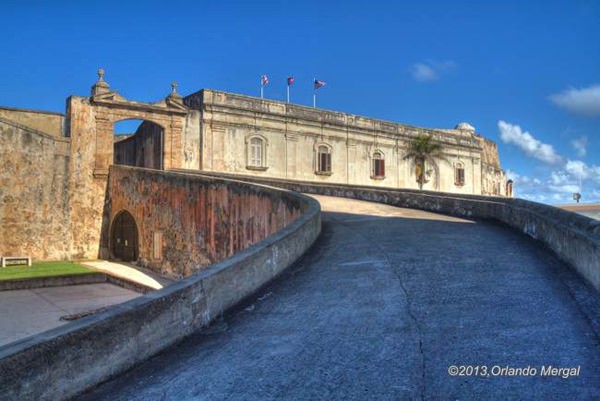
A few steps up Norzagaray street, to the northeast of Plaza Colón, is the remarkable Fort San Cristóbal.
Fort San Cristóbal has two entrances, one on Ponce de León Ave., which is mostly for cars and tour buses, and one on Norzagaray, which is mainly for pedestrians. I suggest using the entrance on Norzagaray.
But before we start up the hill, take a minute to visualize how massive the original Fort San Cristóbal actually was. The portion of the fort that you see today is roughly half the size of the original, and it’s still the largest Spanish fort in the New World.
In 1793, when it was finally completed, Fort San Cristóbal covered over 27 acres and extended all the way down to San Juan Bay. At its highest point, Fort San Cristóbal rises over 150 above sea level.
18th Century San Juan had no tall buildings and none of the buildings that are presently in front of Fort San Cristóbal existed either. So a sentinel could easily see all the way to the edge of the islet towards the east and across the city to Fort San Felipe del Morro towards the west.
In 1897, city officials decided to demolish Santiago Gate, along with a substantial part of Fort San Cristóbal to promote urban development on the eastern side of islet. The demolished portion of the fort included half of the Trinidad Counterguard, the Santiago Ravelin, the Santiago Bastion, Santiago Gate, and a considerable portion of the dry moat.
Ravelins were triangular shaped forts –also called lunettes– that were built in front of bastions to serve as outer defenses. “El Abanico“, which is the outermost of Fort San Cristóbal’s ravelins, and was beautifully restored by the National Park Service is covered under a separate tab.
Fort San Cristóbal also had a glacis, similar to the barren piece of land in front of Fort San Felipe del Morro. This would have been where the Island’s Capitol building stands today, along with the Puerto Rico Olympic Committee, the Casa España, the Athenaeum, the Treasury Department and several other smaller buildings.
After walking up a small stretch of Norzagaray street, you’ll enter Fort San Cristóbal through the western ramp leading to the main gate. Look carefully over the massive wooden doors and you’ll see a shell-shaped symbol with an arc over the top. This was the symbol of Saint James, the patron saint of the Spanish army.
As you enter the fort, the first thing on your left will be the guardhouse. In colonial times, the guards at this post would control access to the fort and enforce military discipline. Today, they’ll charge you a $3 entrance fee and hand out information about the fort and other nearby attractions. They’re also a lot friendlier!
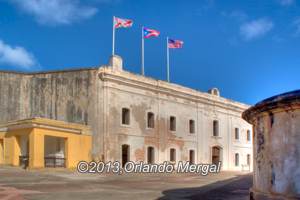
Central square at Fort San Cristóbal
Immediately after the guardhouse you’ll see the main plaza, were Spanish soldiers conducted drills and punished the unruly. But before you walk towards the plaza, take a few steps back and walk up the ramp immediately to the left of the main entrance. This ramp leads to the North Battery, which was added by the Spaniards in 1897 to defend the north side of the fort from sea attacks. Ordoñez canons at this battery, similar to the one you see today, fired the first shots of the Spanish-American War on the morning of May 12th, 1898.
The North Battery also offers an excellent view of the northern side of the city wall, all the way to Fort San Felipe del Morro at the western tip of the islet.
Once you walk back down to the fort entrance turn left and enter the main square. In colonial times, Spanish soldiers conducted all sorts of military exercises in this square and punished the unruly in ways that today would be considered cruel and unusual. Insubordinate soldiers would be forced to walk between two rows of musketeers who would hit them repeatedly with the butt of their muskets. If the soldier fell before completing his punishment, he would be taken to the infirmary, cured and returned to the square for the remainder of his punishment.
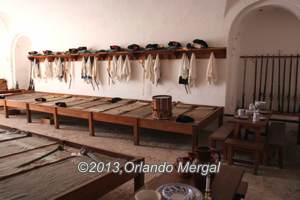
This is what the soldier’s quarters at Fort San Cristóbal would have looked like in colonial times.
At the far end of the main square are the Troop Quarters, a two story building finished in 1733 that had four barrack rooms on each level. One of the rooms has been restored to resemble the typical living conditions of an 18th century soldier. Another holds a scale model of Fort San Cristóbal as it looked in 1793. The remainder of the first floor holds the military archive where students and researchers can obtain in-depth information by appointment only. The center stairway leads to the second floor, which in turn leads to a circular staircase that goes up to “El Caballero de San Miguel”.
Across the main plaza we find the officers quarters and two round wellheads that sit directly over the fort’s massive cisterns. Here you will find several exhibits about the fort’s history including replica canons, weapons and life size figures of Spanish soldiers in uniform.
Like many other things at Fort San Cristóbal, the main square served multiple purposes. It actually sits over five huge cisterns that held up to 716,000 gallons of rainwater; enough to support the fort for an entire year.
The islet of San Juan has no rivers and in colonial times it had no aqueducts either. Spanish engineers worked around this limitation by constructing huge cisterns under the main squares of both forts. Rainwater was collected through channels leading to the forts cisterns. This also meant that cleanliness was of paramount importance. Animals were not allowed inside the forts under any circumstance.
In fact, modern day Puerto Rico would probably be an English speaking island if the Queen’s army hadn’t ignored this fact. In 1598, George Clifford, the Earl of Cumberland attacked San Juan and captured El Morro. However, his fatal mistake was to bring his horses into the fort. Six weeks later, his troops abandoned the city after falling prey to an outbreak of dysentery. Nothing like a little contaminated water to drive the enemy out of town.
On the north side of the square we find a row of vaulted rooms called casemates. The guns in these rooms pointed straight out to sea and their mission was to shoot at the hulls and decks of enemy ships. Their enclosed nature made them practically indestructible.
The last two rooms behind the guardhouse didn’t hold guns at all. The last one housed the latrines and the one before it housed the kitchen.
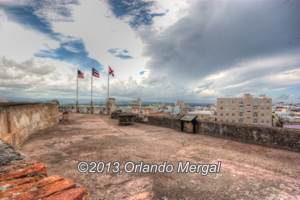
“Caballero de San Miguel”, Fort San Cristóbal
Right next to the Troops Quarter theirs a large ramp that leads to “El Caballero de San Miguel” or cavalier. In military terms, a cavalier is the highest point in a fort or castle and its purpose is to provide a high observation point from which sentinels can observe enemy operations. In colonial times, a sentinel standing at el caballero could see across the entire 47 square mile islet form east to west and north to south. After walking back down the ramp to the main square, you’ll see three large tunnels on the eastern corner.
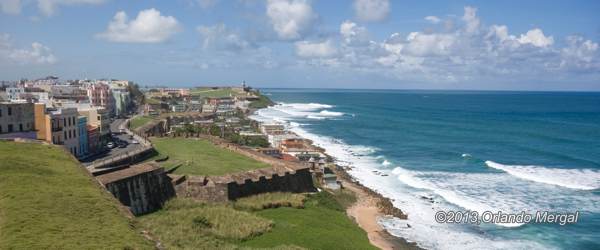
North city wall as seen from “El Caballero de San Miguel” at Fort San Cristóbal.
Fort San Cristóbal has an extensive tunnel system that was used to move supplies, personnel and weapons to different areas. The tunnel on your right goes from the exterior ramp to the fort’s information area and souvenir shop. The other two are physically underneath the ramp.
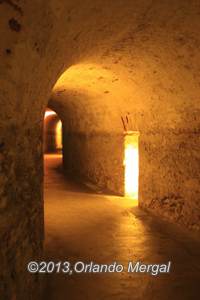
Tunnels at Fort San Cristobal
Of these, the one on the right leads to the main battery on the second level. Canons on this level protected the fort from both land and sea attacks. However, the number of canons wasn’t enough to match the number of embrasures, so they were mounted on wheels and moved around as needed. Larger canons were moved up and down the ramps using a sophisticated rope and pulley system called a block and tackle.
THE DEVIL’S SENTRY BOX
If you walk towards the easternmost corner of the second level plaza you will arrive at a lone sentry box that offers an excellent view of several important areas. As you enter the narrow walkway that leads to the sentry box, right before entering the box, take a look down towards your left and you’ll see the famous “Garita del Diablo” or Devil’s sentry box sitting at the very base of Fort San Cristobal.
Spanish soldiers used Sentry boxes to protect the city walls around the clock. Some of these were close between, but others were more distant and solitary. At night the guards would occasionally shout a call to other guards in their boxes so as to check on their whereabouts and avoid falling asleep.
–Guard, be alert, one would shout. And the nearest would answer back:
–Alert, I am!
Among all the boxes there was one, the most distant and lonely, that sat close to the water, at the very base of Fort San Cristobal. In the silence of the night, the swishing of the sea would produce a noise that seemed as if all the bad spirits were talking to each other.
Soldiers didn’t like this box at all, as rumor had it that strange noises and spirits were heard there every night.
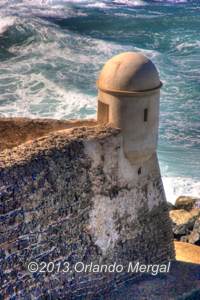
The Devil’s Sentry Box
The night the Devil’s Sentry Box got its name it was Sanchez’ turn to stand guard. Sanchez was born in Andalusia and was a very fair-skinned lad. In fact, he was rather pale, but was still a very handsome man. His fellow soldiers called him Flor de Azahar, after the white flower that grows abundantly in the Andalusian region of Spain. He was a member of the Cavalry Regiment, and was also an excellent guitar player.
As always, the occasional cries from one guard to another were heard, but nothing was heard from Sanchez’ box. Only the whistling wind and the rushing of the sea was heard on that pitch-black night. Fear reigned among the other guards during the remainder of the night, not knowing what could have happened to their friend.
At sunrise, they all rushed to Sanchez’ box to find out why he hadn’t answered.
They found his rifle and his uniform, but Sanchez had vanished without a trace. The superstitious soldiers spread the rumor that he had been surprised and taken away by the Devil. Since that day on, the sentry box was called “The Devil’s Sentry Box”.
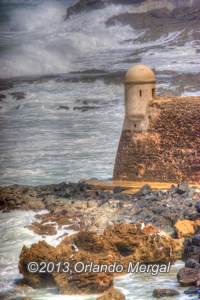
The Devil’s Sentry Box
But very few were aware that Sanchez was in love with a beautiful half-breed girl named Diana. The girl’s stepmother didn’t approve of their relationship, and Sanchez’ commander also prohibited the romance, because of the girl’s dark skin.
But Flor de Azahar would communicate with the girl using his guitar. At night he would play his guitar and sing. In his songs he would communicate his messages to Diana.
One night he sent a message that only she could understand, that said: “Tomorrow at night, go and find your love, because far from your arms, his heart is dying…”
The following night, Diana arose late at night and left her house to find her lover. They met at the Sentry box, where Sanchez was standing guard, and decided to go far away and live together forever.
Diana had brought civilian clothes for Sanchez to wear, so he left his rifle and uniform and the couple escaped to the mountains where they lived happily ever after.
EL ABANICO
As you lift your head forward you’ll see various other important features. In the distance you’ll see the Puerto Rico Capitol building, which sits at the very edge of what used to be Fort San Cristóbal’s glacis.
Right in front of the Capitol building you’ll see a small triangular fort that sits at the very front of San Cristobal’s outer defenses. Its name is “El Abanico”, and from the top it resembles the handheld fans that are so popular among Spanish women.
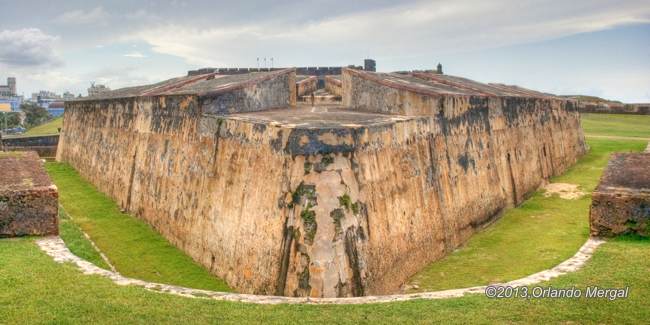
El Abanico
Fort San Cristóbal was a military complex unlike any other that combined layer upon layer of offensive and defensive systems. Would’be attackers would be met by a series of smaller forts called ravelins, which could easily repel less sophisticated forces. Behind the ravelins there was a dry moat where attacking forces would become sitting ducks for the forts archers and musketeers. Atop the walls there were bastions, which were equipped with cannons and musketeers and were much taller and harder to overtake. And above it all was “El Caballero de San Miguel”, which offered a vantage point covering the entire islet and was also equipped with canons and musketeers.
By any standard, Fort San Cristóbal was a military installation like no other in the New World and the prime example of state-of-the-art military engineering in its time.
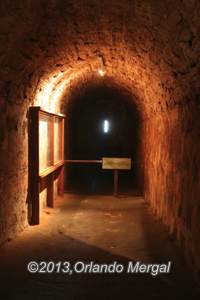
The dungeon at Fort San Cristóbal
THE DUNGEON
This leaves us with only one area of the fort that we haven’t discussed. On the northeast corner of the main square there is still another tunnel that goes right past the fort’s dungeon and ends at the northern end of the dry moat. To the untrained eye, this might seem like an easy way to penetrate the fort. Just go up the tunnel and “voila” you’re in the main square.
But a closer look at the inside of the tunnel will prove this sort of plan suicidal. The large grooves you see every twenty or thirty feet divide the tunnel into sections. If you look close to the floor you’ll also see a series of small niches that could be filled with explosives to bring down that particular section of the tunnel. By placing large removable doors at the grooves immediately behind each section, the Spaniards could selectively demolish sections of the tunnel and stop attackers before they reached the main square.
At the upper end of the tunnel you’ll find the fort’s dungeon, a place so miserable that even today it sends chills up your spine. Imagine a place that’s hot and humid, constantly dark, the air is stale and smells of human excrement. Now throw in a group of sweaty prisoners, rats, roaches and ticks. Oh yeah, and the only source of air and light is a small port at the end of the room, about the size of a small book. This pretty much describes the human living –or dying– conditions inside the 18th century San Cristóbal dungeon.
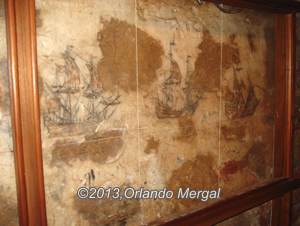
Original drawings by an inmate at the Fort San Cristóbal dungeon
On the left wall, as you enter, there’s a series of drawings made by one of the inmates that is suspected to have been a captain. Experts have come to this conclusion because of the great detail they offer of the ship’s sails and rigging. The red pigment used in the drawings is another clue that the prisoner was no ordinary soldier. It’s a rare substance that contains a great amount of iron, that when exposed to the salty air would oxidize and become a reddish color. Finally, it would have been close to impossible to make these drawings in the dungeon’s pitch-black environment. Therefore, historians suspect that the prisoner had outside help that provided him with some sort of lamp and drawing materials to make his stay less miserable.
As you exit the tunnel, look back over the entrance and observe the little white bomb over the entrance, this will confirm its purpose and design. Immediately to your right there’s a closed door with two small ports at it’s upper left. Place your hand into the ports and feel the cool air coming out. This used to be the fort’s powderhouse and it’s the most protected room in the fort. It’s designed to keep the powder cool and dry and as protected as possible from enemy fire.
If you wish to explore Fort San Cristobal in even greater detail, there are ranger-guided tours that explore every inch of the fort as well as the outer defenses. Ask any park ranger for details.


